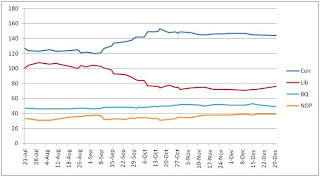 Seat projections are not useful only as snapshots of public opinion, but also as indicators of trends. This chart plots all the projections made since the creation of Canadian Election Watch last summer, according to the date of the projection.
Seat projections are not useful only as snapshots of public opinion, but also as indicators of trends. This chart plots all the projections made since the creation of Canadian Election Watch last summer, according to the date of the projection.During the second half of the summer, nothing much happened: the Tories clung to a narrow lead, and the projections were reminiscent of the 2006 election results. There was an NDP rise over the month of August, but those gains were lost at the beginning of September.
Then, during September and the first half of October, in the wake of Michael Ignatieff's decision to try to bring down the Harper government, the Conservatives climbed steeply, attaining a high of 153 projected seats on October 16, just shy of a majority. The Liberals fell even more rapidly, as the Bloc numbers rose slightly. The NDP was flat during this period.
The second half of October and first half of November were marked by a gentle retreat of the Conservative numbers, and a continued, though much slower, fall of Liberal fortunes. The Bloc continued making slight gains, and the NDP made steep ones, eventually attaining their high of 39 seats.
The second half of November and first half of December were flat for all parties, but a small Liberal rebound in voting intentions produced a modest gain in its seat projection at the end of the year.
Finally, a few thoughts about what these projection trends reveal about the methods that generated them:
Anyone making projections faces a tradeoff between stability and responsiveness. I am rather satisfied with the balance between the two here at Canadian Election Watch. The formula was responsive enough to reflect the changing political scene in September and early October (as opposed to heavily backward-looking formulae that might have taken until November to fully reflect the Tory rise). Yet, it did not produce wild fluctuations (a formula that projects past trends into the future would have given the Tories a comfortable majority in mid-October, only to get back to a minority just a couple of weeks later).
The alternative approaches outlined in parentheses above yield projections that are also predictions, assuming either that future behavior tends to revert to past behavior, or that momentum tends to carry on. Both of these approaches have their merits, but they often produce drastically different results, as was witnessed this fall. I've decided to remain agnostic, and thus Canadian Election Watch's projections are really just that: my best guess at what election results would have been during the latest polling period, with no attempt to account for likely future changes.
And with that, I wish you all a Happy 2010!
No comments:
Post a Comment